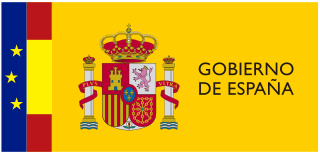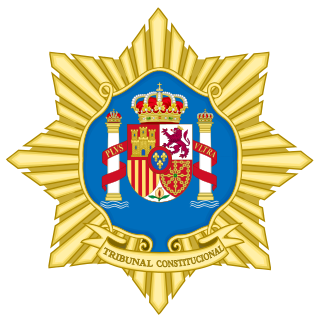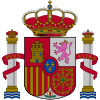
The prime minister of Spain, officially president of the Government, is the head of government of Spain. The prime minister nominates the ministers and chairs the Council of Ministers. In this sense, the prime minister establishes the Government policies and coordinates the actions of the Cabinet members. As chief executive, the prime minister also advises the monarch on the exercise of their royal prerogatives.

The Supreme Justice Tribunal is the highest court of law in the Bolivarian Republic of Venezuela and is the head of the judicial branch. As the independence of the Venezuelan judiciary under the regime of Nicolás Maduro is questioned, there have recently been many disputes as to whether this court is legitimate.

The government of Spain is the central government which leads the executive branch and the General State Administration of the Kingdom of Spain.

The Spanish Constitution of 1931 was approved by the Constituent Assembly on 9 December 1931. It was the constitution of the Second Spanish Republic and was in force until 1 April 1939. This was the second period of Spanish history in which both head of state and head of government were democratically elected.
The Republic of Peru is a unitary state with a multi-party semi-presidential system. The current government was established by the 1993 Constitution of Peru. The government is composed of three branches, being executive, judicial, and legislative branches.

The Constitutional Court is the supreme interpreter of the Spanish Constitution, with the power to determine the constitutionality of acts and statutes made by any public body, central, regional, or local in Spain. It is defined in Part IX of the Constitution of Spain, and further governed by Organic Laws 2/1979, 8/1984, 4/1985, 6/1988, 7/1999 and 1/2000. The Court is the "supreme interpreter" of the Constitution, but since the Court is not a part of the Spanish Judiciary, the Supreme Court is the highest court for all judicial matters.

The Supreme Court is the highest court in the Kingdom of Spain. The court has original jurisdiction over cases against high-ranking officials of the Kingdom and over cases regarding the legalization of political parties. It also has ultimate appellate jurisdiction over all cases. The Court has the power of judicial review, except for the judicial revision on constitutional matters, reserved to the Constitutional Court.

Álvaro de Albornoz y Liminiana was a Spanish lawyer, writer, and one of the founders of the Second Republic of Spain.

Cándido Conde-Pumpido Tourón is a Spanish judge who currently serves as President of the Constitutional Court since January 12, 2023.
The President of the Supreme Court and also President of the General Council of the Judiciary is the highest judicial authority of the Kingdom of Spain and holds the representation of the judicial branch and its governing body, the CGPJ. The office of President of the Supreme Court is foreseen in the Constitution as well as giving to the president the presidency of the General Council of the Judiciary. As a parliamentary monarchy, the President of the Supreme Court is appointed by the Monarch after being nominated by the Plenary of the General Council of the Judiciary, who serves until the end of its 5-years-term, its dismissal by the CGPJ or its resignation.

The governor of the Bank of Spain is the head of the Bank of Spain, the central bank of the Kingdom of Spain. The Bank of Spain is integrated in the European System of Central Banks and, as such, the Governor is an ex officio member of the Governing Council of the European Central Bank.

Pascual Sala Sánchez is a Spanish jurist. He was president of the Spanish Supreme Court and of the General Council of the Judiciary between 1990 and 1996, and was later president of the Constitutional Court, between 2011 and 2013.

Marisol Peña Torres is a Chilean jurist and educator.
Juan Ignacio Campos Campos was a Spanish attorney, lieutenant attorney of the Supreme Court of Spain between 2020 and his death in 2021.

The General Council of the Judiciary blockade was a constitutional crisis that has resulted in the General Council of the Judiciary (CGPJ), the governing body of the Judiciary in Spain not being able to fulfill its functions due to the inability of the Spanish Parliament to agree on the appointment of a new council since the term of the last council expired in 2018. The most serious of these functions in abeyance are the selection of the President of the Supreme Court and the appointment of judges to the Supreme Court and the Constitutional Court.
The Judgment of the Constitutional Court of Peru over the dissolution of Congress on 30 September 2019 was court ruling determining that the actions of President of Peru Martín Vizcarra dissolving the Congress of Peru were legal within the laws outlined in the Constitution of Peru. The judgement would build upon previous rulings, determining that Congress could not regulate the motion of no confidence.























